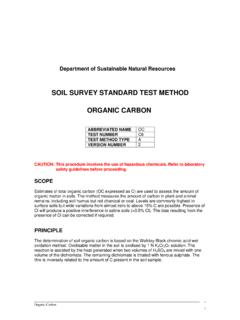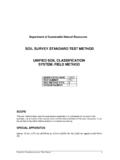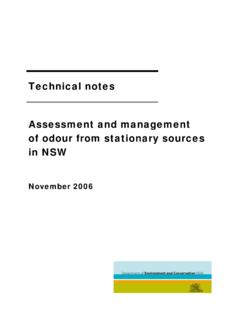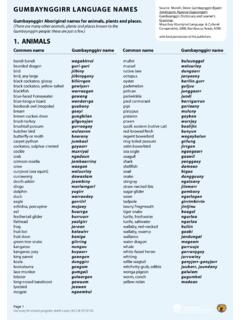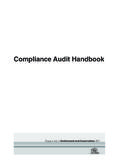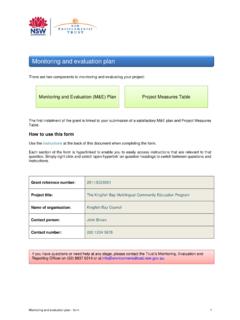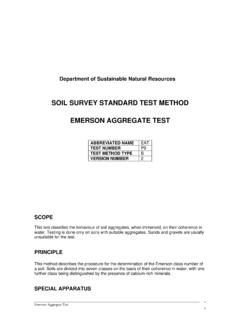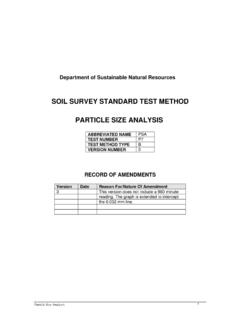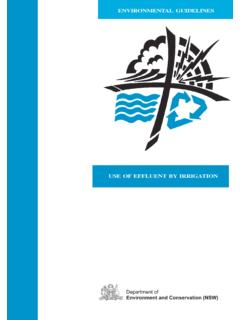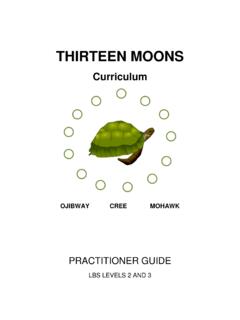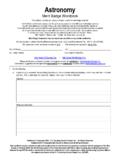Transcription of Bird survey methods - NSW Environment, Energy and Science
1 Bird surveymethodsBaseline1 Bird survey methodsBaseline surveyAnimal welfare Avoid close-range observation wherever possible duringbreeding and feeding. Avoid overuse of mimicry calls as they can distract birds. Do not disturb nest sites as birds may abandon eggs or chicks. Do not, under any circumstances, remove eggs from a nest. It is illegal to trap birds in NSW without a scientific licence fromNPWS. It is illegal to undertake a research study on birds in NSW withoutanimal ethics collection methods ?All of the data collection methods relating to baseline surveys listed below are explained indetail in the rest of this AnimalhandlinglicencerequiredPoint count6 Opportunistic6 Claire Carlton, National Parks Association2 Setting up your transect A 500 metre transect has been chosen to use as an example. Use flagging tape tomark out the start and finish points and then five points, 100 metres apart are markedout along the transect.
2 Point one is located 50 metres from the beginning of thetransect and all other points are 100 metres apart (see Figure 1 below). Imagine a bullseye target at each pointalong the transect. When standing ateach transect sample point for a ten-minute period, birds seen or heardwithin the bullseye are recorded. heareas are divided up as 0 15 metres,then 15 30 metres and finally 30 50metres from the middle of the samplepoint. All birds entirely outside thebullseye area but within the samehabitat are recorded as opportunistic. T Put flagging tape up at distances of 15,30 and 50 metres from each samplepoint along the transect to assist withrecording the distance birds have beenseen from the transect. Each sample point along the transectshould be marked with flagging tape. Each sample point should be assigneda unique identification number to beentered onto the birds field data sheet inthe first column in the observationstable.
3 The position of each sample point onthe transect (in metres) and its samplearea identification number should bewritten onto the flagging tape. This tapemust be removed when the survey isfinished as it may be confusing for futuresurveys. On a topographic map recordwhere the transects are located andkeep this as a permanent 2: Example of 500 metre transectmid-pointSample pointsTransect line0 m 50 m150 m250 m350 m450 m500 mFigure 2: Laying out the bullseye targets on a 500 metre transect0 m50 m150 m350 m450 m250 mTransect lineSample points15 m30 m50 m25 m25 m3 Point count methodThe basic method that has been chosen is based on setting up a single line at eachsite called a transect. Birds can be identified either visually, or by their calls. Thismethod involves identifying all the birds you see or hear while standing at a series ofpoints along a transect (a straight line through the site).
4 A systematic search (over a fixed area and/or for a fixed time) such as the methodspecified here has the added advantage of providing an index of the abundance ofindividuals and species, which can be later compared with other sites where thesame systematic search method was used. The reliability of the abundance indexcan be reduced by either overestimates or underestimates of bird numbers. Toreduce overestimates, particularly when several team members are observing, try toensure that each individual bird is recorded only once. Inexperience bird watchersmay find they need to refer to books to aid identification, which will reduce the timespent watching and may result in underestimates of abundance. Hence, ensurethat a least one member of the team is watching at all needed Compass Topographic map of survey area Clipboard, pencil and eraser Small notebook for making your own notes of special events seen Watch Bird field data sheets (one set for each survey site) Plastic sheets or large clear plastic bag to protect data sheets whenraining Bird field guide Binoculars: 8 10X magnification and 40 50 millimetres field of view,that is, 8x40; 10x42; 10x50.
5 Lens tissue to clean the binocular lens and glass Whistle for when separated from group Flagging tape or strips of coloured material Cassette recorder, cassette tape and spare batteries to record unknownbird calls (optional)Point countmethodBird survey teams should: Be small in size with two to fourmembers in each team; Have one team member nominated asthe scribe and therefore be responsiblefor accurately and consistentlyrecording the bird observationsprovided by other team members; and Speak and move quietly and avoidsudden count should be conducted on alltransects each day the survey is running,unless weather conditions are such that itwould be difficult to see or hear the transects should be surveyed in adifferent order each day because the birdsobserved will vary depending on the time counts are conducted at the start offirst light which is before sunrise.
6 This is thetime when birds vocalise most, and isknown as the dawn chorus . It is also atime of maximum bird movement as birdsmove through the bush to begin feeding. Alltransects should be finished within 3 to 4hours after first cold mornings keep your binocularsinside clothing when not in use. This willreduce fogging when you are lookingthrough check where you are standing whenyou stop to view a bird, as ants have littlerespect for busy bird steps you need to follow to use thismethod the team at the first samplepoint on the transect; 10 minutes note on the appropriatediagram the identity and position ofeach bird species seen or heard. (Seethe notes on how to fill out the birdsurvey field data sheet in the followingsection.) the end of the recording period thebird names should be transcribed to theobservation table.
7 Data entry should becompleted for all the observations forthe first recording period before movingon to the next sample point. Thisshould be done as quickly as possible,as the dawn chorus is data transcription is completed,the team moves quietly to the nextpoint on the transect. Note any birdsyou observe while walking on theopportunistic sightings field data steps 2, 3 and 4 until all samplepoints on a transect have observers may record the sameindividual bird, and effort should be made(by comparing the positions of the birds byeach observer) to note that individuals arerecorded only once on the data data sheetPhysical environmentSee Recording site details bookletMoonSeveral descriptions of moon phases areprovided, please tick descriptions of rain conditions areprovided, please tick coverVisually estimate the percentage of skyobscured by point identification numberEach sample point should be assigned aunique identification number to be enteredin the first column in the observations timeFor this sample area.
8 Use 24 hour clock,eastern standard timeFor this sample area. Use 24 hour clock,eastern standard species codeEnter the four digit species code from thelist of bird species provided in the FieldWorkbook. If you cannot find a species inthe list then leave this entry blank. A codewill be found species nameEnter the species name from the table ofbird species in the Field Workbook to the5manual. An abbreviated name isacceptable. Enter the common andscientific typeUse the single letter observation codesprovided in the Field Workbook to recordthe type of observation relating to of individualsThe distance from the sample point to abird is estimated and the number ofindividuals at the distance is recorded in theappropriate columns which are 0 15metres, 15 30 metres, 30 50 main value of noting whether birds areobserved within a 0-15m, a 15-30m or 30-50m radius of the sample point is that itenables you to compare your resultsbetween sites with varying densities ofvegetation (and hence varying visibility)after your survey is completed.
9 Wherevegetation is dense and visibility isconsequenlty restricted to (for example)30m, there is a much smaller area in whichbirds cna be observed than at a site wherevisibility is 50m or more. The actualabudnance and species diversity of birdsmay be the same at both sites, but the sitewith denser vegetation will have a lowercount simply because a smaller area canbe observed from the sample point. Theresults can be adjusted for variable visibilityby excluding observations made at siteswith better visibility which are 30-50m fromthe sample point. All sites can then bePoint countmethodcompared using only birds seen within a 0-15m and 15-30m radius of the record the number of individuals thathave definitely been seen or heard. Forexample when one or two thornbills areseen there are generally more around butassumptions cannot be made when fillingout the data sheets.
10 Only actual birdsidentified and counted should be unsure whether an individual has alreadybeen counted, it is best to assume that ithas that an individual bird is likely tomove around the site during yourobservation, and try to avoid counting thesame individual more than opportunistic bird sightings or hearingsshould be recorded on an opportunisticanimal sightings field data sightings or hearings includeall birds seen or heard outside therecording time period of ten minutes spentat each sample point. This situation mayoccur when team members are walkingbetween sample points or setting up thetransect. If a bird is flying over the transect,even during the recording time period,without stopping they are recorded as aopportunistic bird seen or heard outside the samplearea boundary of 50 metres but during theten minute recording period should be listedon the opportunistic sightings field tufted honey eaterNPWS6 Special considerations and tips Weather such as wind, heavy rain, mist, fog, haze and electrical storms aregood reasons not to conduct a bird survey .
